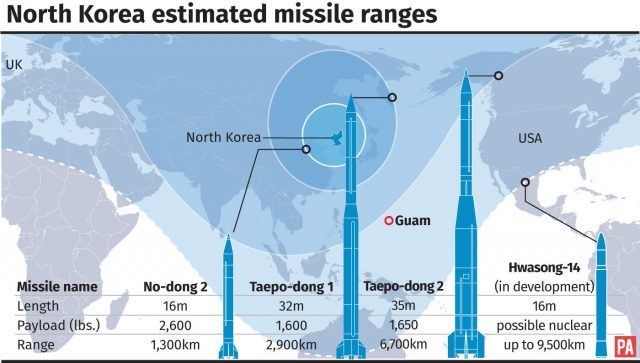PRESIDENT Donald Trump has declared that the US nuclear arsenal is “far stronger and more powerful than ever before”, even as his top diplomat was working to calm the North Korea crisis and insisting there was not “any imminent threat”.
In a series of early-morning tweets, President Trump reaffirmed his threat from a day earlier by reposting video of him warning that Pyongyang would be “met with fire and fury like the world has never seen” if it made more threats to the US.
Then he said that his first order as president had been to “renovate and modernise” the US nuclear arsenal.
In December, before being sworn into office, President Trump called for the United States to “greatly strengthen and expand its nuclear capability” until the rest of the world “comes to its senses” regarding nuclear weapons.
After his inauguration, he ordered a review of the nation’s nuclear posture to ensure that US capabilities were modern and robust, but the White House has not detailed any findings from that evaluation.
Efforts to modernise the nation’s ageing nuclear stockpiles pre-date Mr Trump’s presidency.
My first order as President was to renovate and modernize our nuclear arsenal. It is now far stronger and more powerful than ever before….
— Donald J. Trump (@realDonaldTrump) August 9, 2017
…Hopefully we will never have to use this power, but there will never be a time that we are not the most powerful nation in the world!
— Donald J. Trump (@realDonaldTrump) August 9, 2017
In 2016, then-defence secretary Ash Carter said the Pentagon planned to spend 108 billion US dollars (£83 billion) over five years to sustain and improve its nuclear force.
President Trump tweeted on Wednesday: “Hopefully we will never have to use this power, but there will never be a time that we are not the most powerful nation in the world.”
Only hours before, Secretary of State Rex Tillerson urged calm and said Americans should have “no concerns” despite the exchange of threats between the president and North Korea.

Aboard his plane as he flew home from Asia, Mr Tillerson insisted the developments did not suggest the US was moving closer to a military option to dealing with the crisis.
“Americans should sleep well at night,” Mr Tillerson said.
He added: “Nothing that I have seen and nothing that I know of would indicate that the situation has dramatically changed in the last 24 hours.”
The mixed messages from Mr Tillerson and President Trump put the onus on the North Koreans to decide how to interpret the latest missives from the US.
In more tranquil terms than President Trump, Mr Tillerson sought to explain the thinking behind Mr Trump’s warning.
He said the president was trying to send a strong and clear message to North Korea’s leader so that there wouldn’t be “any miscalculation”.
The @UN Security Council has unanimously adopted resolution on further sanctions on #NorthKorea. $1 billion in new export bans. #DPRK pic.twitter.com/yfaC5316ZS
— UK at the UN ?? (@UKUN_NewYork) August 5, 2017
“What the president is doing is sending a strong message to North Korea in language that Kim Jong Un can understand, because he doesn’t seem to understand diplomatic language,” Mr Tillerson said.
“I think the president just wanted to be clear to the North Korean regime on the US unquestionable ability to defend itself.”
He said the US “will defend itself and its allies”.

Enjoy the convenience of having The Sunday Post delivered as a digital ePaper straight to your smartphone, tablet or computer.
Subscribe for only £5.49 a month and enjoy all the benefits of the printed paper as a digital replica.
Subscribe